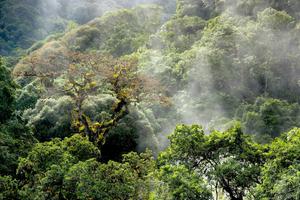In 2024, researchers at the Royal Botanic Gardens, Kew, recorded 172 new species of plants and fungi across the globe, from England to Cameroon.
Scientists highlighted 10 particularly remarkable species described this year.
- Plectocomiopsis hantu, a climbing palm in Borneo called wi mukoup or wee mukup by locals, who use the plant for weaving. Scientists call it the “ghost palm” owing to the stark white undersides of its leaves.
- Russula neopascua, a fungus growing around willows in the Rocky Mountains that, like closely related fungi, smells distinctly of fish.
- Aphelandra almanegra, a shrub that grows in the dry forests of northwest Colombia and produces a spectacular pink flower. Its name, almanegra, means “black soul” in Spanish, a reference to its black heartwood.
- Afrothismia winkleri, a plant that draws all of its nutrients from neighboring fungi, without need for photosynthesis. This species, found in African forests, has no green coloring and appears above ground only to fruit and to flower.
- Virectaria stellata, an herb from West Africa that sprouts unusual star-shaped hairs. The plant was found on sandstone cliffs in Guinea.
- Phellodon frondosoniger, an inky black fungus discovered near Windsor, England, that exchanges nutrients with broadleaf trees such as oaks. Unlike other fungi, it does not sport gills on its underside, but instead has pointy, teeth-like protrusions.
- Chlorohiptage vietnamensis, a flowering plant that grows in limestone karst in Vietnam. Scientists are unsure what insects would pollinate its green flowers. The species is critically endangered, as miners are clearing away that limestone that forms its habitat.
- Dendrobium cokronagoroi, one of several dazzling orchids recorded in Indonesia. This flower comes from West New Guinea.
- Keita deniseae, a new vine found in the Boyboyba forest of Guinea. Its name honors the late Guinean biologist Sékou Moussa Keita and Guinean botanist Denise Molmou.
- Cheniella hechiensis, a new species of vine found in southern China. The species is under threat from development.
Scientists note that many of the plants identified this year are already at risk of extinction. Among those not yet recorded by science, an estimated three in four are under threat, according to a report from Kew.
“The devastating reality is that more often than not, new species are being found on the brink of extinction and it’s a race against time to find and describe them all,” said Martin Cheek, a senior researcher with Kew. He added that the loss of plants has implications for humans: “Every unknown species we lose could have been a potential new food or new medicine that we never even knew existed.”
ALSO ON YALE E360
How Traffickers Got Away with the Biggest Rosewood Heist in History









